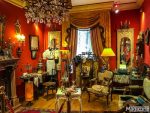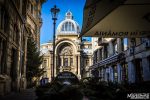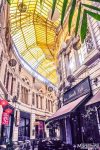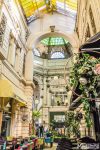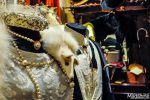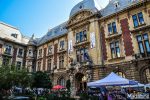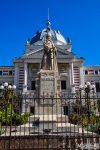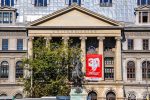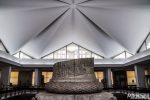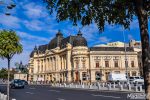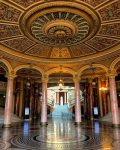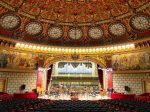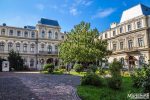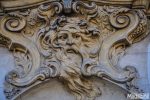While Bucharest may only trace its origin back to late medieval times, it has still served as a gateway between the east and the west, ever since Vlad III, also known as Vlad Dracula, mentioned a fortress in Bucharest as his “princely residence” in 1459.
For centuries, Bucharest has been at the crossroad between the Christian kingdoms to the west, the Tsars of the east and the Ottoman Empire to the south.
It was in this melting pot of influences, that Bucharest experienced its prime back in the second half of the 1800s, when the country prospered under king Carol I. Following a great fire in 1847, that sent 1/3 of the city up in flames, there was need for new construction. Beautiful boulevards were laid in French style, luxurious palaces were constructed and the face of the city was defined by the architecture of the Belle Époque style.
These important years from 1848 to 1930s shaped the city and is the reason why it was known all over Europe as the “Little Paris of the East”.
Then followed the Depression, the 2nd World War and a communist dictatorship, that saw the construction of unimaginative, grey concrete containers, that exemplify the Stalinist architecture. They also form part of the picture, that is now Bucharest.
But because of these dark, grey boxes, the pearls of the Belle Époque era shine even brighter.
Much of the Belle Époque architecture of Bucharest may be obliterated by World War bombings, an earthquake in 1977 and the “redevelopment schemes” of Ceausescu in the 1980s – under which an overall area of eight square kilometres of the historic centre of Bucharest were levelled – but that just means that the remaining buildings are even more precious. That the architecture is more treasurable.
Here are the best places in Bucharest to unearth these bygone treasures, with a map of them all in the end:
LIPSCANI QUARTER – THE HISTORIC AREA
The historical quarter is the best place to immerse yourself fully in the Belle Époque charm of Bucharest, as the concentration of architectural gems is the most dense. On the map at the bottom of the article, you can locate these treasures and start your own treasure hunt. Here, I have listed my favourites first:
CEC Palace
Built between 1896-1900 where the church of St. John had been demolished 25 years before, the imposing building of the CEC was constructed to the plans of the French architect Paul Gottereau.
Of elegant proportions, the CEC Palace, built in eclectic style, is adorned with a glass and metal dome, whose transparency adds a charm to the building. Unfortunately, it’s not possible to visit the inside.
Macca-Vilacrosse Passage
No metropolis, expanding in the late Victorian times worth of its salt, could do without an arcaded shopping gallery. It was just THE vogue of the time.
In the late 1880s, the city decided to buy the on-site luxury shops owned by Macca plus the inn called Vilacrosse to build a Western style passage to relieve congestion. It was designed by architect Felix Xenopol, and opened in 1891.
Because the central part of the site was occupied by the Pesht Hotel, which the owner refused to sell, the passage was executed as a two-tined, fork-like shape with two wings around the two sides of the hotel. The narrow streets were covered with a glass roof, allowing the entry of natural light while providing shelter from the rain. The ground floor was meant for shops, while the rooms on the first floor were for rent. One branch of the passage was called Vilacrosse, while the other one was called Macca, after the old owners.
Today, no hotel and only a few shops remain, but instead the beautiful passage is full of cafés and has become popular with shisha smokers. Sit and smoke some shisha or have a coffee, and think how an eastern tradition now occupies the architectural symbol of a nation trying to liberate itself from its former, eastern oppressors.
Little Paris Museum – Muzeul Micul Paris
While there’s a fair amount of museums in Bucharest you shouldn’t waste your time visiting, some are definitely worth your time and petty cash.
We were delighted by the treasure trove that is Muzeul Micul Paris. Here, you can step into the fabulous era of Belle Époque and imagine yourself living in a time when Bucharest was known as “Little Paris of the East”.
By the time we visited, they didn’t charge a fee, but asked a donation at about 10 Lei per person.
Stock Exchange Palace
Built in 1907, the former Stock Exchange used to be the National Library, before that moved to its present, modern location. The style is French neoclassical, with pillars and columns in Corinthian style.
Now, the interior of the building is just a shadow of its former glory. A vintage market is held in the erstwhile reading room at the lower level and everything looks like it’s dilapidating. It’s worth to take peak inside, though, and take in its former, palatial ambiance.
National Bank of Romania – old palace
The Old Palace of the National Bank is considered “the most beautiful building in Bucharest” by architect Ion Mincu. It was constructed from 1883-1885 after the plans of architects Albert Galleron and Cassien Bernard.
The contrast between the strictness and un-ostentatiousness of the facades’ architecture and the decorative richness of the interior is evident. Therefore, both public spaces on the ground floor and the representation spaces on the first floor surprise visitors. The majestic, Greek style palace to the north is built later, in the 1940ies.
It’s possible to visit the inside of the majestic buildings and acquire some knowledge about both the architecture and the history of coins and currency in Romania on a free, guided tour (which we can heartily recommend!) of The Museum of the National Bank of Romania when scheduled at least 48 hours before on this web page.
Palace of the former Dacia Insurance Company
Some sources claim, that the Palace of the former Dacia Insurance Company was built in 1882-1889. Other sources say, that it was built between 1911-1912 in the classic Viennese style, initially as the headquarters of a branch of a bank from Berlin.
Whatever the truth, fact remains that the monumental facades are decorated with allegorical sculptures representing Justice, Trade, Industry and Agriculture.
The palace was supposed to house the city’s Pinacoteca and exhibit some of the 5.500 pieces of art the Pinacoteca’s collections consist of, but for some reason that hasn’t happen.
Until it does, you can only admire its sumptuous exterior.
Caru’ cu bere
Probably the most famous brewery in Bucharest, Caru’ cu bere opened in 1879 and now features a very popular restaurant.
The asymmetric façade, marked by a console tower with the spire roof and Gothic decorative details were partially covered by scaffolding due to renovations works when we visited. It’s apparently going on for 7 years, so they are not in a hurry. The gothic revival building was designed by Austrian architect Siegfrid Kofczinsk and a medieval, Austrian beer cellar may come to mind as you enter the dark, heavily populated room.
They serve savoury dishes in generous portions – as you can see on Tripadvisor – and the beer is great too!
Palace of Ministry of Agriculture
The sumptuous Palace of the Ministry of Agriculture and Rural Development was built in 1895 following the plans of Swiss architect Louis Pierre Blanc . The building housed the ministry from the beginning to the present.
Unfortunately, you can only admire the building from the outside, unless a special event takes place, in which circumstance you may be able to visit the courtyard or even the interior. Your best chance of locating such an event is via their Facebook page. Yes: Welcome to the 21st century!
Sutu Palace – Bucharest Municipality Museum
The Sutu Palace was erected between 1833-1835 in neo-gothic style , following the plans of Viennese architects Conrad Schwink and Johann Veit. It is one of the oldest aristocratic buildings in Bucharest and one of the very few edifices that remained unchanged in its 150 years of existence.
Bucharest’s Municipality Museum is probably the most informative of the history of Bucharest with most information in English as well, and you get a chance to admire its sumptuous interior for only 10 Lei / 2,5€ per person.
Colțea Hospital
The current hospital is the latest in line of proud hospitals that previously occupied the site. The Colțea Hospital was first erected in 1704 by the first architect of the nation, Mihail Cantacuzino, then redesigned between 1836 and 1842 by architect Heinrich van Fausser and then modernized in 1849. The building you see today was built between 1867-1888 by Dutch architect Joseph Schiffler.
It is designed in a French academic style, with classical facades and symmetrical composition. Better wish to see it from the outside, though – it’s still a working hospital!
University of Bucharest
The Palace of the University facing the square is 6-storey high, built in neoclassical style on the former site of the Saint Sava Monastery and was completed in 1869. I think it’s superfluous to say, that it’s the largest university in Romania??
It’s possible to visit the Museum of University of Architecture and Urbanism Ion Mincu and gain some precious insights to the architecture of Bucharest. Even though the museum is located inside a part of the University dating only back to 1927, the building is a splendid example of the neoromanesc or New Romanian Style by Grigore Cerchez. This style emerged as a consequence of the Belle Époque; providing the splendid, new and modern mansions with a traditional look that became unique for Romania.
National Museum of Romanian History
The museum is located inside the former Postal Services Palace and dates back to 1892, where the architect, Alexandru Săvulescu was sent with the postal inspector to tour various postal facilities of Europe for the design.
The final sketches were influenced primarily by the postal facility in Geneva. Built in an eclectic style, it is rectangular with a large porch on a high basement and three upper floors. The stone façade features a portico supported by 10 Doric columns and a platform consisting of 12 steps spanning the length of the building.
There are many allegorical sculptural decorative details.
When we visited, only a tiny segment of the museum was open: Trajan’s Column (or rather, a copy of it) the treasury and a couple of temporary exhibitions. The rest remains closed after (too) many years of restoration and the staff were rather discouraged about the museum’s future. In my opinion, you shouldn’t waste your time here if you’re searching for information about Romanian history. For the second best thing: history about Bucharest, visit the Municipal Museum in Sutu Palace.
CALEA VICTORIEI – ALONG THE BOULEVARD
Besides the historic quarter of Lipscani, with its high density of Belle Époque buildings, the main boulevard Calea Victoriei also houses some of the most exquisite examples of the old-world architecture. Although considered the city’s poshest boulevard, Calea Victoriei isn’t Champs-Élysées. It’s too begrimed by dilapidating, Stalinist architecture to be so. Even so, that makes the venerable architecture stand out that much brighter.
Cișmigiu Park
We start, not at Calea Victoriei, but in the lovely nearby park – our favourite green spot while visiting.
In 1847, the landscape gardener Wilhelm Mayer – former director of the Imperial Gardens in Vienna – was charged with transforming an unhealthy spot of land into a beautiful garden. Together with fellow gardener Franz Hörer, they continued creating a green lung of the city well beyond its inauguration in 1854.
Today, it’s a popular spot amongst old and young alike, to sit and watch people stroll by. If you’re feeling particularly romantic, you can rent a boat and row around the pond and finish off with a glass of sparkling wine at the lakeside restaurant.
Kretzulescu Palace
“I could live here,” I inform my husband as I take in this fairytale gothic mansion with its Victorian glasshouse just outside Cișmigiu Park.
Kretzulescu Palace was built in 1902 under the supervision of Petre Antonescu, commissioned by Elena Crețulescu to rebuild the historical residence of the Crețulescu family. Unfortunately, it’s not possible to visit the inside, but ahh; just to stand in front of the breath-taking palace is worth a detour.
Grand Hôtel du Boulevard
The elegant Grand Hôtel du Boulevard for a long time counted as the best hotel in Bucharest. The land on which it is located was purchased on 1865 by businessman Herdan, who ordered in 1867 the start of construction, after the plans of architect Alexandru Orăscu.
It’s scheduled to open again as a hotel in 2020 and is currently undergoing interior renovation. The exterior has been beautifully restored and looks in mint condition.
National Military Club
Standing guard imposingly, this neoclassical masterpiece in French style, designed by Romanian architect Dimitrie Maimaroiu, was built in 1912 to serve the social, cultural and educational needs of the Romanian army.
The main part of the National Military Club is off-limits to civilians, but the sumptuous restaurant and summer terrace is open to the public.
Casa Capșa
Casa Capșa is a legendary place in Bucharest, situated in Calea Victoriei and opened in 1852.
The building was expanded in 1886, when Grigore Capsa opened a hotel and a café. By introducing French and Viennese style confectionery, like chocolate and ganache, Casa Capșa formed part in superseding the previous Ottoman desserts like baklava and sarailie.
As with the architecture, Romanians were eager to look to the west and adopt new traditions, breaking the shackles of Ottoman authority. So, sit and have cake here and enjoy a bite of history!
Grand Hotel Continental
Erected or renovated on the site of the former Grand Hotel Broft from 1869, the majestic Grand Hotel Continental got its present Viennese visage in 1890 and remains one of the most luxurious hotels on Calea Victoriei.
The boutique 5 star hotel offers 53 rooms and 6 apartments of pure luxury, and was re-opened in 2010 after two years of restoration and modernization.
Central University Library Carol I
The Central University Library was founded in 1895 as the Carol I Library of the University Foundation. It was built on land bought by King Carol I of Romania for the “Carol I University Foundation” and designed by French architect Paul Gottereau.
During the Romanian Revolution of 1989, a fire was started in the building and over 500.000 books, along with 3.700 manuscripts, were burnt. Yeah, I wept a little too when I read that!
They are open for guided visits Tuesday, Wednesdays and Thursdays between 10:00 and 14:00 after appointment via email.
Romanian Athenaeum
The gorgeous, domed structure of the Romanian Athenaeum is home to Filarmonica “George Enescu” and will blow your mind when you enter the concert hall. It was designed by French architect Albert Galleron and built between 1886 and 1888. The overall style is neoclassical, with some more romantic touches.
You can either pop in to snap a picture (for a fee) in the entrance hall or book a guide to enter the impressive concert hall. Or even better: Enjoy a concert! The tickets are surprisingly cheap and will buy you an experience of a lifetime!
Romanit Palace – Museum of Art Collections
The Museum of Art Collections is located inside the Romanit Palace, the first section of which was built in 1822.
The palace was lavish and the luxurious interior was treasured by the nobility of its time. They would have looked at thick silk curtains from Damascus and Aleppo. Chairs and sofas, all mahogany and ebony, inlaid with mother-of-pearl, and gilded bronze figures dressed in Cordova leather. In all the chambers, chandeliers hung from ceilings with garlands between doors and windows, all of Venetian crystal.
The museum offers a collection of paintings, sculptures and artworks, but perhaps a bit to the boring side.
Cantacuzino Palace – George Enescu National Museum
The National Museum “George Enescu” was opened in the Cantacuzino Palace, one of the most beautiful buildings in Bucharest, a historical monument and one of the European Heritage Label buildings. The sumptuous entrance, in Art Nouveau style, underlines the luxury and the refinement of the era, embodied in one of the most imposing palaces in Bucharest.
Built in 1901-1902 by Gheorghe Grigore Cantacuzino, the former mayor of Bucharest and leader of the Conservative Party, the architectural ensemble was designed by architect Ioan D. Berindei. For the decoration of the building, the architect collaborated with several recognized artists of the time.
The museum itself is meagre, and only covers a few rooms of the palace, but features an interesting collection of George Enescu’s belongings.
More info
Below I’ve provided the above information in a Google Map, hoping it can help you in your treasure hunt for the beautiful Belle époque architecture of this multi-facetted city. Further down some useful links.
Learn more

